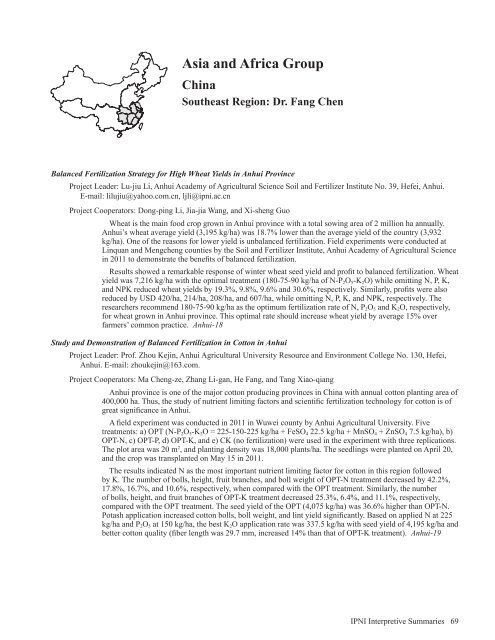Americas and Oceania Group - International Plant Nutrition Institute
Americas and Oceania Group - International Plant Nutrition Institute
Americas and Oceania Group - International Plant Nutrition Institute
Create successful ePaper yourself
Turn your PDF publications into a flip-book with our unique Google optimized e-Paper software.
Asia <strong>and</strong> Africa <strong>Group</strong><br />
China<br />
Southeast Region: Dr. Fang Chen<br />
Balanced Fertilization Strategy for High Wheat Yields in Anhui Province<br />
Project Leader: Lu-jiu Li, Anhui Academy of Agricultural Science Soil <strong>and</strong> Fertilizer <strong>Institute</strong> No. 39, Hefei, Anhui.<br />
E-mail: lilujiu@yahoo.com.cn, ljli@ipni.ac.cn<br />
Project Cooperators: Dong-ping Li, Jia-jia Wang, <strong>and</strong> Xi-sheng Guo<br />
Wheat is the main food crop grown in Anhui province with a total sowing area of 2 million ha annually.<br />
Anhui’s wheat average yield (3,195 kg/ha) was 18.7% lower than the average yield of the country (3,932<br />
kg/ha). One of the reasons for lower yield is unbalanced fertilization. Field experiments were conducted at<br />
Linquan <strong>and</strong> Mengcheng counties by the Soil <strong>and</strong> Fertilizer <strong>Institute</strong>, Anhui Academy of Agricultural Science<br />
in 2011 to demonstrate the benefits of balanced fertilization.<br />
Results showed a remarkable response of winter wheat seed yield <strong>and</strong> profit to balanced fertilization. Wheat<br />
yield was 7,216 kg/ha with the optimal treatment (180-75-90 kg/ha of N-P 2 O 5 -K 2 O) while omitting N, P, K,<br />
<strong>and</strong> NPK reduced wheat yields by 19.3%, 9.8%, 9.6% <strong>and</strong> 30.6%, respectively. Similarly, profits were also<br />
reduced by USD 420/ha, 214/ha, 208/ha, <strong>and</strong> 607/ha, while omitting N, P, K, <strong>and</strong> NPK, respectively. The<br />
researchers recommend 180-75-90 kg/ha as the optimum fertilization rate of N, P 2 O 5 <strong>and</strong> K 2 O, respectively,<br />
for wheat grown in Anhui province. This optimal rate should increase wheat yield by average 15% over<br />
farmers’ common practice. Anhui-18<br />
Study <strong>and</strong> Demonstration of Balanced Fertilization in Cotton in Anhui<br />
Project Leader: Prof. Zhou Kejin, Anhui Agricultural University Resource <strong>and</strong> Environment College No. 130, Hefei,<br />
Anhui. E-mail: zhoukejin@163.com.<br />
Project Cooperators: Ma Cheng-ze, Zhang Li-gan, He Fang, <strong>and</strong> Tang Xiao-qiang<br />
Anhui province is one of the major cotton producing provinces in China with annual cotton planting area of<br />
400,000 ha. Thus, the study of nutrient limiting factors <strong>and</strong> scientific fertilization technology for cotton is of<br />
great significance in Anhui.<br />
A field experiment was conducted in 2011 in Wuwei county by Anhui Agricultural University. Five<br />
treatments: a) OPT (N-P 2 O 5 -K 2 O = 225-150-225 kg/ha + FeSO 4 22.5 kg/ha + MnSO 4 + ZnSO 4 7.5 kg/ha), b)<br />
OPT-N, c) OPT-P, d) OPT-K, <strong>and</strong> e) CK (no fertilization) were used in the experiment with three replications.<br />
The plot area was 20 m 2 , <strong>and</strong> planting density was 18,000 plants/ha. The seedlings were planted on April 20,<br />
<strong>and</strong> the crop was transplanted on May 15 in 2011.<br />
The results indicated N as the most important nutrient limiting factor for cotton in this region followed<br />
by K. The number of bolls, height, fruit branches, <strong>and</strong> boll weight of OPT-N treatment decreased by 42.2%,<br />
17.8%, 16.7%, <strong>and</strong> 10.6%, respectively, when compared with the OPT treatment. Similarly, the number<br />
of bolls, height, <strong>and</strong> fruit branches of OPT-K treatment decreased 25.3%, 6.4%, <strong>and</strong> 11.1%, respectively,<br />
compared with the OPT treatment. The seed yield of the OPT (4,075 kg/ha) was 36.6% higher than OPT-N.<br />
Potash application increased cotton bolls, boll weight, <strong>and</strong> lint yield significantly. Based on applied N at 225<br />
kg/ha <strong>and</strong> P 2 O 5 at 150 kg/ha, the best K 2 O application rate was 337.5 kg/ha with seed yield of 4,195 kg/ha <strong>and</strong><br />
better cotton quality (fiber length was 29.7 mm, increased 14% than that of OPT-K treatment). Anhui-19<br />
IPNI Interpretive Summaries 69

















